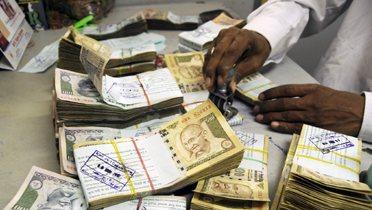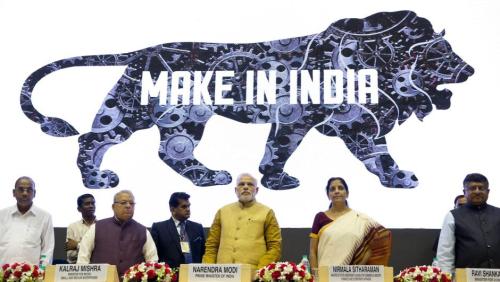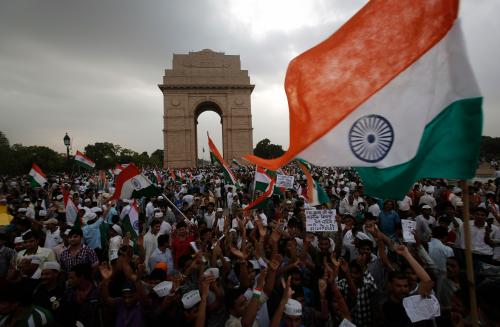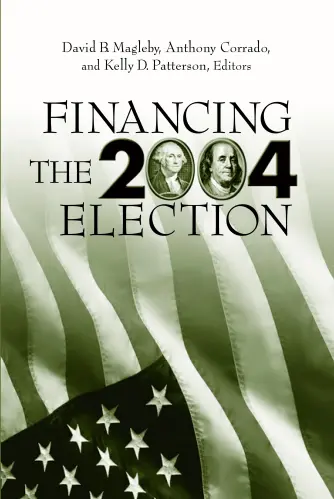Content from the Brookings Institution India Center is now archived. After seven years of an impactful partnership, as of September 11, 2020, Brookings India is now the Centre for Social and Economic Progress, an independent public policy institution based in India.
Prime Minister Narendra Modi’s government has picked up the pace of domestic reforms and seems increasingly willing to engage with foreign partners of all stripes as part of its strategy to promote growth. Of these partners, the United States shares a considerable array of interests with India that provide a good foundation on which to build a strong bilateral economic relationship. The challenge remains that of framing these issues in a manner that highlights how making progress on them would be in the mutual interests of the two countries.
India’s economic prospects have improved considerably since Modi took office. The economy has revived after hitting a rough patch in 2013-14, with GDP growth likely to exceed 6 percent in 2015, although the manufacturing sector continues to turn in a lackluster performance. Disciplined monetary policy has brought down inflation and the government seems committed to fiscal discipline even as revenue growth falters, while falling oil prices have helped to bring down the current account deficit. The government is moving ahead with labor market reforms, disinvestment from public sector enterprises, measures to promote financial inclusion, and reforms of the banking system. The pace and scope of reforms could certainly be improved but there is no mistaking the commitment of the government to a broad array of much-needed second generation market-oriented reforms.
Despite a weak external environment, the Indian economy seems poised to achieve higher growth in 2015 than last year. Indeed, in terms of positive growth momentum, the U.S. and India are the two bright spots among the Group of Twenty (G20) economies. This provides a propitious environment for the two countries to strengthen their bilateral economic ties.
An obvious dimension in which the two countries would benefit is providing broader access to each other’s markets for both trade and finance. India is a rapidly growing market for high-technology products (and the technology itself) that the U.S. can provide while the U.S. remains the largest market in the world, including for high-end services that India is developing a comparative advantage in. Both of these dimensions of bilateral trade could fit in to the rubric of Modi’s “Make in India” campaign, turning that into a campaign to boost productivity in the Indian manufacturing and services sectors rather than have that slogan serve as a guise for protectionist measures that would not serve India well in the long run.
The two countries recently succeeded in negotiating an arrangement to address India’s concerns about food security in the context of multilateral trade negotiations, helping to revive the stalled World Trade Organization trade facilitation agreement. This was an indication of the ability of the two sides to work together in dealing with important but complicated and contentious areas. The two countries could also work together to help India develop a property rights regime and a framework for dealing with patent issues in a way that makes progress on meeting concerns of both sides. This could serve as a broader template for dealing with a key source of friction amongst other advanced and emerging market economies.
While India’s trade regime has been liberalized considerably over the years, there are still some sectors, such as food distribution, where domestic policies related to subsidies and direct government involvement create barriers to trade. Bilateral discussions might help prod the Indian government to undertake reforms that would be good for the domestic economy, both directly and by promoting external trade and financial flows.
A bilateral investment treaty would help provide a framework for U.S. investors to share in different aspects of the Indian growth story and for Indian corporations that are eager to spread their wings into the United States. Investment barriers have been reduced on both sides, but there are still regulatory restrictions—such as the constraints on foreign direct investment in multi-brand retail in India – that could be brought down more quickly within such a framework to encourage rapid growth in bilateral investment flows. In this context, the announcement in the September 2014 joint declaration for setting up the Indo-U.S. Investment Initiative to be led by the “Ministry of Finance and the Department of Treasury, with special focus on capital market development and financing of infrastructure” is significant.
The recent approval of higher limits on foreign ownership in Indian firms, in sectors such as defense and insurance, along with broader easing of restrictions on foreign direct investment inflows, provides an excellent opportunity for U.S investment in India. This could also provide a boost to the government’s objective of reducing its share of ownership in public sector firms and financial institutions. Investment flows from the U.S. could have the twin benefits of helping the government secure a good price for its asset sales and simultaneously initiate the transfer of technology and expertise from the U.S. to India.
India needs better financial markets, including a more vibrant corporate bond market. This is an important priority for the new government, which recognizes the need to build a broader set of financing opportunities for Indian firms and entrepreneurs. U.S. investors who want to share in the India growth story would find this a suitable avenue for doing so and India would benefit from having a more stable source of long-term capital for its domestic financing needs, especially on items such as infrastructure that have a long gestation period. The U.S. could provide useful technical guidance on the soft infrastructure and regulatory frameworks that are necessary for developing a robust and stable corporate bond market.
The Reserve Bank of India has already signaled that financial development and inclusion, within the context of a strong regulatory regime, are important priorities for promoting stronger and more equitable growth in India. The government has put its weight behind the financial inclusion program, and an impressive number of Indian citizens have already signed up for bank accounts. Efficient and well-regulated financial markets that effectively channel domestic savings into productive investments are essential for India’s growth and development. While the U.S. is hardly the paragon that it was once considered to be, there are still many aspects of financial market development and regulation where India has some important lessons to learn from the U.S.
India and the U.S. are natural allies but need a better foundation of trust to work together to promote their common interests, including in international forums. For its part, the U.S. must help build this trust by frontally addressing India’s concerns in bilateral and multilateral discussions, and also by delivering on the Obama Administration’s commitment to governance reforms that would give India and other emerging markets their due voice in international organizations and forums. The second Obama-Modi summit in January 2015 would be the logical venue to renew and operationalize these commitments.









